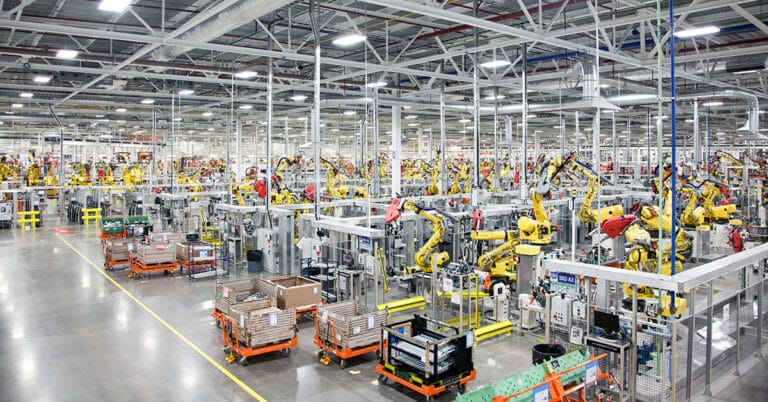What could your factory produce if it ran at full speed with no quality problems for every one of the 8,760 hours in a year?
Now compare that with the actual output. Almost certainly, there’s a lot of potential.
This is the idea behind the Total Effective Equipment Performance metric: to see what is theoretically possible and then identify ways of moving towards that ideal.
What is total effective equipment performance (TEEP)?
Total effective equipment performance (TEEP) compares what was produced with the theoretical maximum output. It’s a measure of potential that shows what could be achieved if everything that stops or slows production of saleable product was eliminated.
TEEP helps managers identify underused production capacity, especially during off-shifts, weekends or idle periods. It’s not strictly a maintenance metric, but maintenance activities (planned and unplanned) directly affect it. So do shift structures, breaks, meetings and demand fluctuations.
Like Overall Equipment Effectiveness (OEE), TEEP includes losses resulting from machines running at less than 100% of full speed, and losses due to quality problems. For investigating those though, OEE is sufficient. Where TEEP differs is in its focus on availability. It considers downtime and periods where machinery is idle, identifying opportunities to increase production, utilization and efficiency.
Quick Definitions:
- TEEP: Total Effective Equipment Performance = actual output vs. theoretical max output over full calendar time
- OEE: Overall Equipment Effectiveness = output vs. theoretical max during planned production time
How is TEEP calculated?
The formula is:
TEEP = (Availability) x (Performance) x (Quality) x (Utilization)
Each component plays a role:
- Availability = Time equipment is scheduled to run ÷ total calendar time
- Performance = Actual speed ÷ maximum speed
- Quality = Good units ÷ total units produced
- Utilization = Time equipment is scheduled to produce ÷ total calendar time
TEEP reveals how close a process comes to achieving its maximum potential or fully productive time, which represents 100% performance, quality and utilization across all calendar hours. Performance loss typically occurs when the actual cycle time exceeds the ideal cycle time, reducing the net run time, which reflects the period when equipment is operating efficiently to produce good units.
The longest period over which TEEP is used is a year. It may also be measured quarterly, monthly or even weekly. Shorter periods are of less value as numbers will be influenced by unusual or random events; the important point is to be consistent over all components.
Example Calculation:
If a machine has 80% availability, 90% performance, 95% quality and 70% utilization, its TEEP is:
0.80 x 0.90 x 0.95 x 0.70 = 47.88%
This means the machine is producing at just under 48% of its full potential across the entire calendar year.
TEEP vs. OEE (overall equipment effectiveness)
Anyone familiar with OEE will recognize that TEEP is OEE multiplied by the availability percentage. TEEP considers the full 24/7 operational potential while OEE focuses on equipment effectiveness only during scheduled operating hours.
From a maintenance perspective, OEE considers only unplanned downtime, which is, of course, disruptive and costly, but planned maintenance is excluded because it’s an important activity. However, planned maintenance still eats into hours that could otherwise be used for production. TEEP calls attention to this and promotes moves towards predictive maintenance solutions that aim to reduce all maintenance-related downtime.
More broadly, the difference is that while an OEE score helps improve performance during operational shifts, TEEP provides insights into equipment’s full potential utilization, including non-working hours.
TEEP goes a step further, asking: what if this machine ran more often? It calls attention to:
- Missed production outside scheduled hours
- Opportunities to increase utilization
- Ways to reduce planned production gaps
In this way, TEEP supports proactive capacity planning. Teams using both metrics can improve real-time operations (with OEE) and long-term asset ROI (with TEEP).
Why is TEEP important for manufacturing?
TEEP has no direct bearing on maintenance or quality performance; other metrics do this better. Its value is in helping managers identify where to look for ways to increase the utilization of existing assets. Three specific applications are:
Maximizing equipment utilization
TEEP identifies where equipment could be running but isn’t. Shift changeovers, meal breaks, team meetings and lack of demand are all reasons for a low Availability component in the TEEP calculation. By drawing attention to this unused potential, TEEP pushes managers to identify underutilized capacity, which can avoid capital expenditure on new equipment and consider all means of optimizing production schedules.
Utilization losses often hide in plain sight — empty shifts, unscheduled weekends, short runs or fluctuating demand. Tools like MES and CMMS systems can uncover this. By visualizing idle capacity, teams can reschedule work or reallocate labor to better use existing assets across the production process.
Identifying bottlenecks
Bottlenecks are one of the biggest causes of low equipment utilization. They arise from unbalanced capacity throughout the manufacturing process, resulting in downstream operations being underutilized. Bottlenecks are often obscured by inventory and differences in shift patterns and maintenance schedules, but are a major cause of inefficiency. Applied to departments or machines, TEEP will show where utilization is high and where it drops off dramatically, highlighting the bottleneck operation or process.
Example: A press brake with 90% performance but only 40% availability may signal scheduling or upstream issues. Fixes include shift staggering, better capacity balancing or revised production priorities.
Improving ROI
TEEP helps managers find additional capacity within their plant. With this information they can increase output without buying new equipment and improve ROI from existing fixed assets. The result is to dilute overheads and lower unit costs, which in turn allows more competitive pricing and creates opportunities to win more business.
It also ties into sustainability: better asset use reduces energy and material waste. Maximizing asset use boosts production output, allowing organizations to meet demand with fewer capital expenditures. When TEEP improves, cost-per-unit drops, margins rise and long-term investments pay off.
Steps to improve TEEP
TEEP is not a one-time metric — it thrives in environments committed to continuous improvement, where small operational changes compound over time to deliver major gains in efficiency and utilization.
Managers are often dismayed when they first start measuring TEEP. Almost inevitably, the percentage is very low and there is a great deal of opportunity to make improvements. The question they must then address is — how and where should those improvements be made?
Improving total effective equipment performance means focusing on the four levers of the formula. Here’s how:
Reduce downtime
- Use a data-driven maintenance strategy to anticipate failures
- Monitor asset health with sensors or condition monitoring
- Implement lubrication, inspection and wear tracking routines
Preventive maintenance solutions, such as regular inspections and lubrication, along with replacing consumable items such as filters and those prone to wear like belts, will reduce unplanned stoppages. However, with any PM there is always the risk of doing too much or the wrong type. This is addressed with predictive maintenance, which uses machine health monitoring to detect increasing failure probability, allowing maintenance to be delayed until failure is imminent.
Increase availability
- Overlapping shifts or flexible staffing can reduce line stoppages for breaks
- Analyze planned production schedules to shrink idle time
- Streamline changeovers and reduce planned downtime windows
Enhance performance
- Use root cause analysis (RCA) to diagnose slowdowns
- Invest in operator training to ensure machines run at top speed
- Digitally track downtime and speed loss causes to find trends
Ensure equipment operates at maximum efficiency by addressing performance issues such as chronic stoppages and reduced speed running. Improving speed and eliminating micro-stoppages not only drives TEEP but also boosts OEE performance, leading to higher asset efficiency during both scheduled and unscheduled timeframes.
Help for increasing maintenance effectiveness
When equipment fails unexpectedly, both operating time and output consistency suffer — reducing TEEP and introducing unnecessary variability into production. TEEP shows managers what could be achieved with existing production assets. The strategic insights this metric offers help increase ROI, capacity and output while driving down unit costs.
Adopting TEEP often leads to a renewed focus on the time spent maintaining production machinery. While PM is essential, and therefore excluded from OEE calculations, it still reduces the total hours for which machines are available. One way of tackling this is to adopt a predictive maintenance strategy.
Maintenance strategy directly affects TEEP, especially availability and utilization. Strategies that support high TEEP include:
- Predictive maintenance based on real-time machine data
- Lubrication and inspection routines to prevent wear-related failures
- Component wear tracking to optimize part replacement timing
- Use of a CMMS for scheduling and documentation
With these tools, maintenance teams can reduce both planned and unplanned downtime, enabling more consistent production and better equipment performance.
As a leader in outsourced industrial maintenance, we help manufacturers address short and long-term challenges and improve the effectiveness of their maintenance operations. Contact us for more information.






